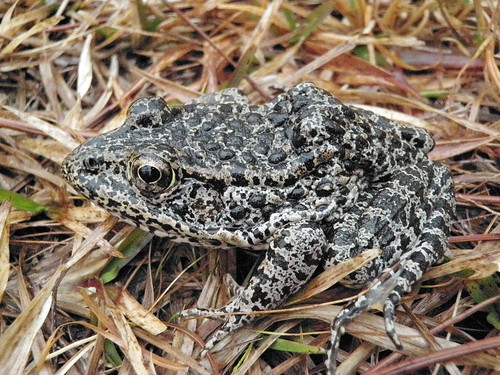
To most people, the sound heard near Pony Ranch Pond could easily be mistaken as snoring. To local conservation professionals, however, it was more like a song, signifying hope and celebrating a small victory for the nearly extinct dusky gopher frog.
In February, National Forests in Mississippi staff, researchers and volunteers discovered and documented six dusky gopher frogs at the De Soto National Forest pond. One frog, a 5-year-old female, had travelled nearly a mile from nearby Glen’s Pond – until then the only known site where the endangered amphibians live and breed.
“This is a great success because the frogs found the pond on their own,” said Ed Moody, a wildlife biologist with the De Soto Ranger District.
The frog thrives in native longleaf pine ecosystems and spends most of its time in stump holes and burrows – often those made by the gopher tortoise, a threatened species. The shallow, fishless, ephemeral and isolated wetlands embedded within the longleaf pine woodlands provide the habitat that breeding adults and tadpoles need to thrive.
As part of the restoration process, Forest Service staff groomed the Pony Ranch Pond, making it larger and deeper and removed a lot of woody vegetation.
“We’re already planning on working on another nearby pond. There’s a good chance the frogs will start going there as well,” he said.
Historically, the dusky gopher frog was found across parts of southwest Alabama, southern Mississippi and southeast Louisiana. But a number of obstacles threatened its existence, including commercial development, paved highways, new subdivisions, hurricanes, tornados, wildfires, and dried-out water basins.
In 2012, the frog was identified as one of the top 100 most endangered species in the world by the International Union for the Conservation of Nature.
“Everything really goes together. Once you lose a species, that’s it. It’s lost. If we can save a species from extinction, then we should,” said Moody.
Forest Service management includes a regular prescribed burning regimen to maintain healthy habitat for the frog. Land managers plan about 2,300 acres of longleaf pine restoration for similar ponds in the area.
The success of the dusky gopher frog is part of the De Soto’s strategy to restore 13,400 acres of longleaf pine over nine years as part of the U.S. Department of Agriculture’s Collaborative Forest Landscape Restoration Program.

